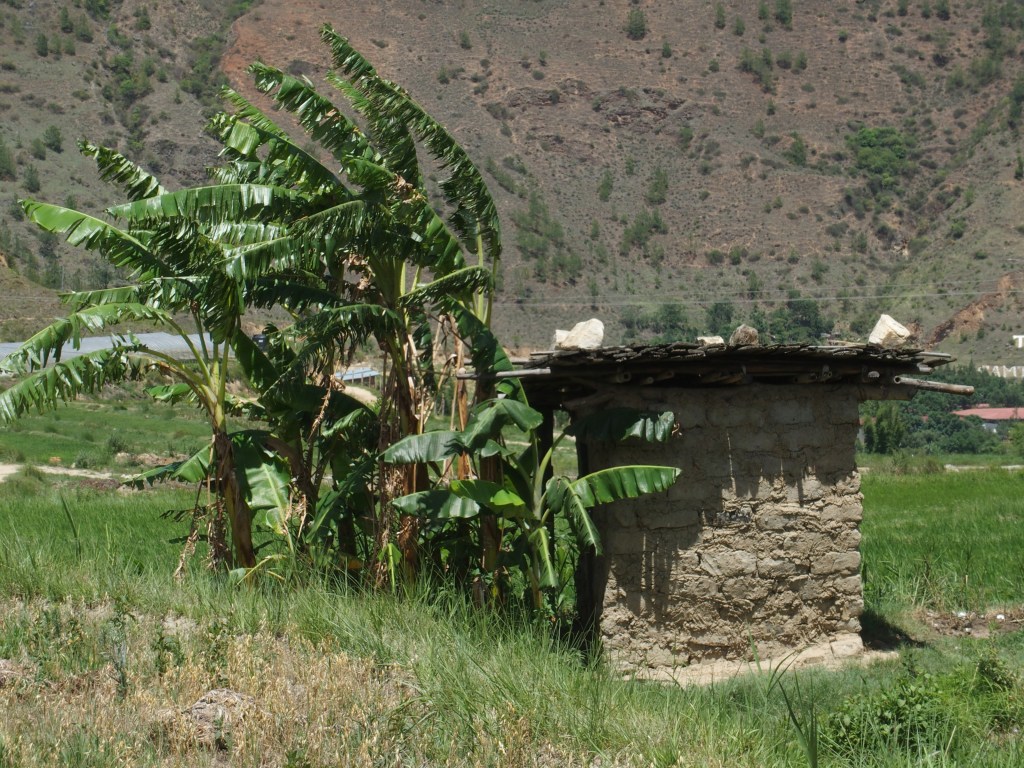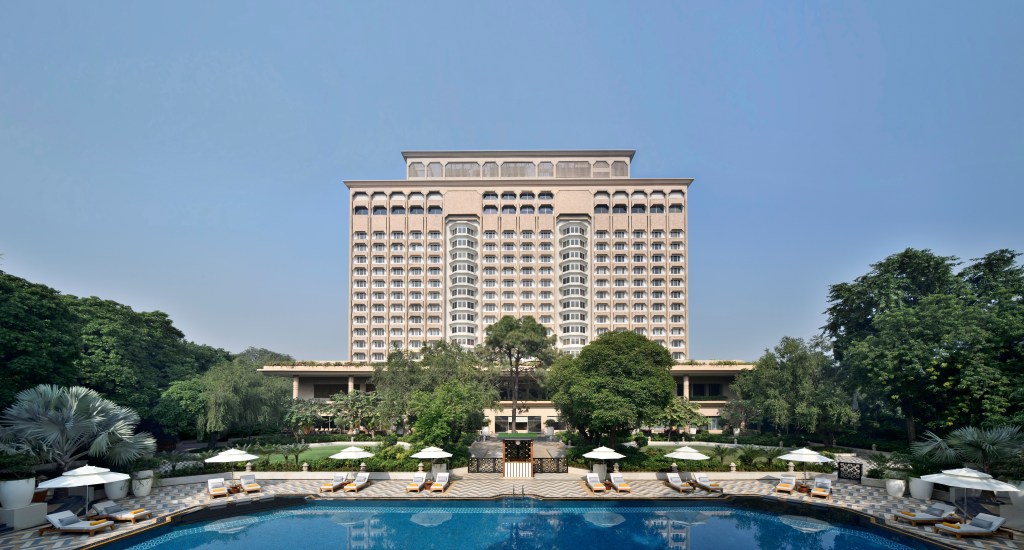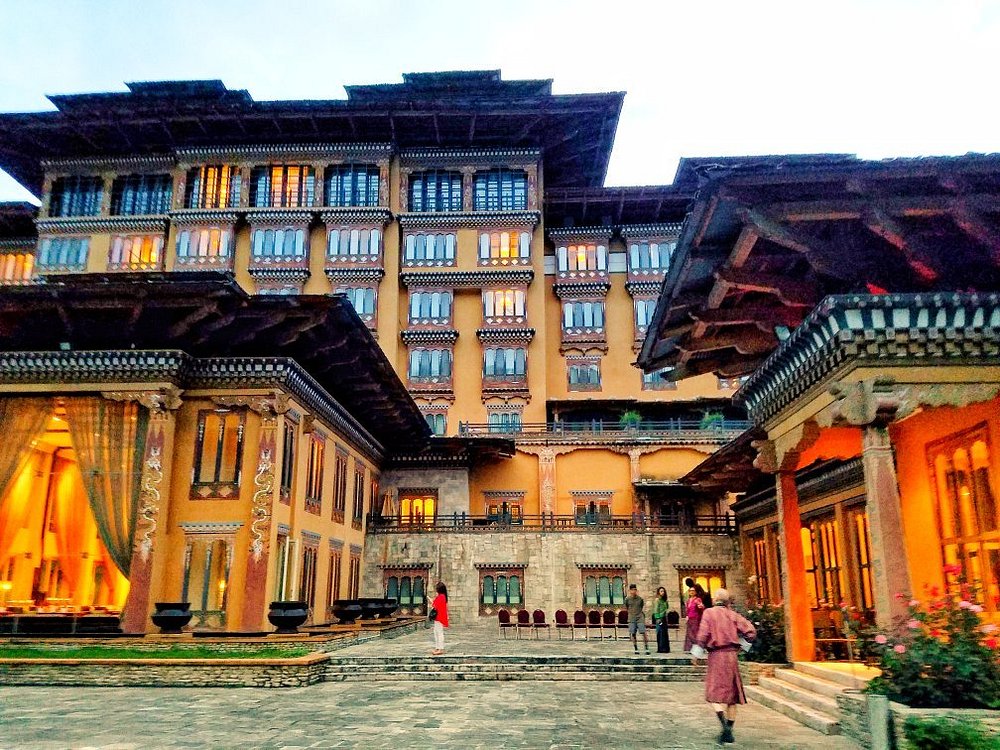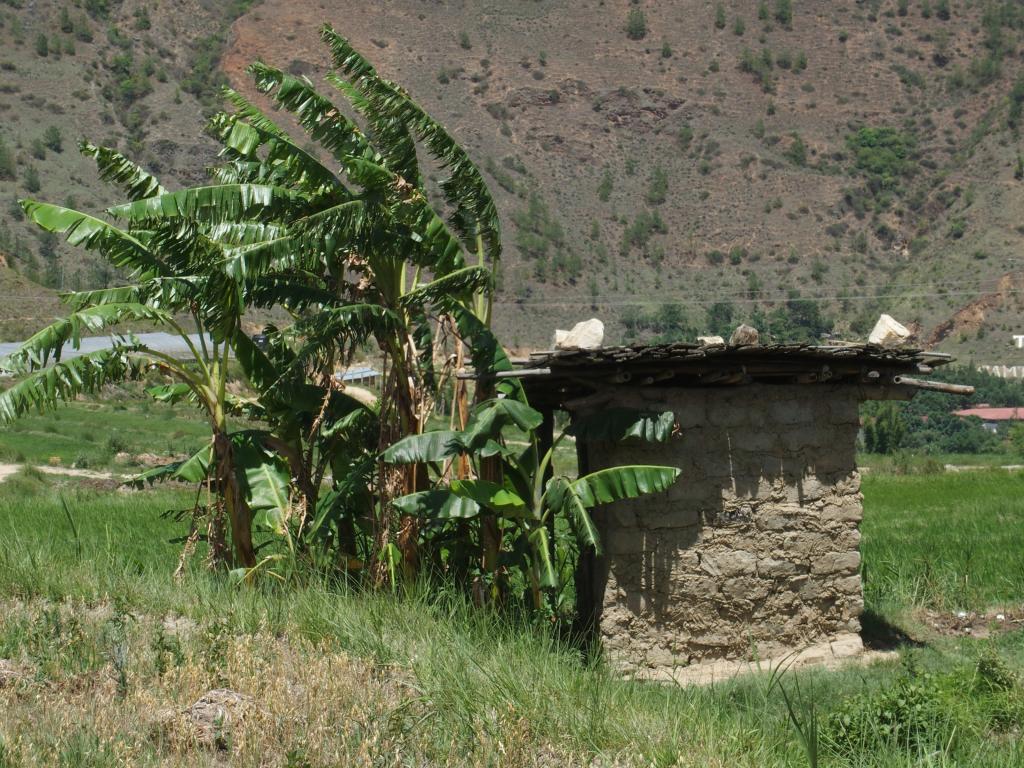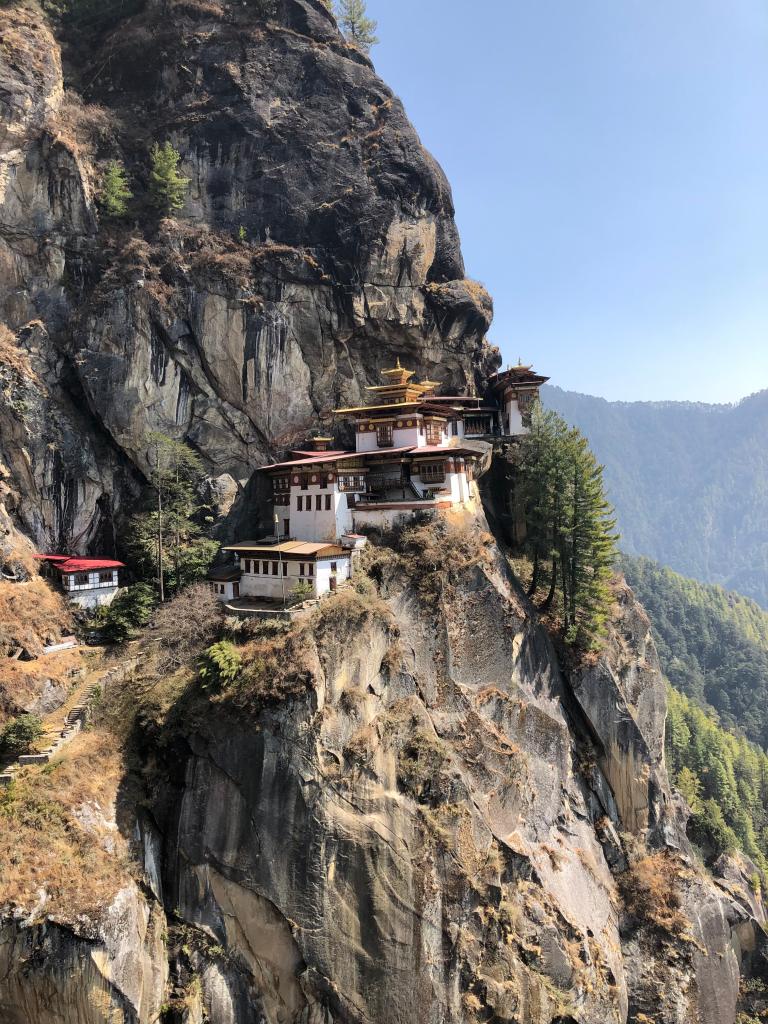Your guide will tell you that, if you are lucky enough to be in Bhutan, you did something good in a past life. Maybe so.
Landlocked against India, China and Tibet, and surrounded by the Himalayas, the nation has kept itself to itself. Only accessible via remote mountain passes, modern education only made it to this “Land of the Thunder Dragon” in the 1960s. Then, in the 1970s, tourists began trickling in. Television arrived in the ’90s. The internet and cell phones came just 20 years ago.
The wearing of national costume (the gho for men, kira for women) is very much de rigueur, adding to the “lost in time” atmosphere of the country.
Unspoiled and virtually unchanged, it’s carbon negative, its forests absorbing more than the largely rural country emits. The hugely popular king, His Majesty the Druk Gyalpo Jigme Khesar Namgyel Wangchuck, decreed that Bhutan will not deign to count gross national product, but rather gross national happiness. (It’s a concept explored in the new film, “Agent of Happiness,” a Sundance film festival award nominee, out this month.)
Tourism here is strictly monitored. Travel must be booked through a certified tour agency who will arrange your stay and your visa, which involves the pre-payment of a daily impact fee. This recently dropped from $250 per day to $100 per day. But that price no longer covers the cost of any entry fees, or your Bhutanese tour guide, also compulsory.
What the fee does cover is sustainability efforts, infrastructure and job creation. The aim is to attract “high-value, low-volume” tourism and it seems to work, with Bhutan getting less than 10% of the visitors as nearby Nepal.
No wonder, since to get here you fly first to Delhi and then on to Bhutan’s only international airport, Paro, where you’ll face one of the most dangerous landings in the world. It requires specially licensed pilots who fly in on visuals only to wind perilously close to the mountains before taking a hard right to a short landing strip that appears only at the last minute.
Your reward is what has to be the world’s most beautiful airport. All modern buildings in Bhutan must echo the traditional architecture and building techniques that set Bhutan apart, so everywhere you look, you’ll see white houses emblazoned with tigers and dragons, with intricately carved wooden beams even on simpler structures. There are no nails used anywhere either; joists keep the buildings up and rocks keep the roofs down.
An hour’s drive away from Paro, the capital of Thimphu is overseen by the giant golden Shakyamuni Buddha Dordenma, built on the mountainside in 2015. It’s one of the world’s tallest Buddhas at 169 feet and fulfills a prophecy that says it will bestow blessings and bring happiness and peace to the world. Inside the base, you’ll find more than 100,000 little Buddha statues.
The city itself is a great place to buy crafts, and the colorful farmer’s market is rich with locally grown, organic produce. Take a peek at the Bhutanese national animal, the takin, a yak-like creature unique and native to the country, in the city’s royal preserve nearby.
To see critters in the wild, travel to the north for snow leopards, south for Bengal tigers. For the nation’s most famous animal, the mythical yeti, head for Sakteng Wildlife sanctuary in Trashigang where 460 square miles have been set aside specifically for Bigfoot’s cousin.
In the evening, you may encounter traditional dances or even a blessing ceremony with a Buddhist monk at the Pemako Thimphu hotel (from $820, half board). It artfully blends old and new, and impresses with huge windows offering soaring vistas.
Heading northeast from the capital towards Punakha takes you up ear-popping mountain roads with hairpin turns. In just over half an hour, you’ll reach Dochula Pass at 10,301 feet. It’s the spot to take in a 180-degree view of the snow-capped Himalayas, including the highest unclimbed mountain in the world, Gangkhar Puesum, at 24,836 feet. In Bhutan, you can’t climb any of the mountains, since it’s where the gods live. It keeps them free of Nepal’s mountain blight of trash and dead bodies.
The next stop is Chhimi Lhakhang, a rustic temple built on a hillside in 1499, and blessed by 15th-century monk Drukpa Kunley. Known as “the Divine Madman,” he thought religion had become too boring and promoted singing, dancing, drinking, swearing and, most importantly, having lots of sex. He claimed that women would find enlightenment by indulging in some hanky-panky with him, and some 5,500 of them allegedly obliged.
Consequently, the temple is now a pilgrimage site for couples looking to conceive. The man is taken to do chores, while the woman must hoist a huge wooden phallus onto her back and walk round the temple three times. After prayers and blessings, a monk will announce when the baby will be born along with its sex. A big book of photos in the temple attests to babies successfully foretold.
It’s the mad monk’s legacy as the owner of the “Thunderbolt of Flaming Wisdom” that’s behind the Bhutanese fascination with phalluses. Throughout the country you’ll see huge, carefully painted phalluses on the sides of houses, and big wooden ones proudly displayed inside, to ward off evil spirits. Some have ribbons, some, scarily, have smiley faces; others have very hairy balls and have patently just arrived at a happy ending.
Exit the temple through the local shops for some phallic mementos, the perfect backdrop for your next work Zoom call.
Half an hour onward at Punakha, the landscape changes to tiered paddy fields, where the staple red rice grows, along with plenty of chillies (eaten as a vegetable, not a spice). The Mo Chu and Po Chu rivers wind through, and here you’ll find the new luxury sanctuary, andBeyond Punakha River Lodge (from $890 all inclusive).
Opened in September, a stay at the lodge is reminiscent of being on safari — no surprise, since South African company andBeyond owns 29 luxury safari lodges.
It’s composed of just six tent-roofed wood structure suites, with the soaking tubs and sound of the river rushing below, and two villas built in Bhutanese style, with private plunge pools. Excellent dining is courtesy of executive chef Rudolf van der Westhuizen, who previously worked at the &Beyond camp in Botswana. He blends western tastes with local dishes, fusing Indian, Chinese and Bhutanese flavors.
“We have problems with procurement and basic necessities of things we’d find easy to get in the West,” said van der Westhuizen. “The Bhutanese diet is quite limited compared to other countries — lots of cheesy potatoes with chillies — so I’m playing around with ideas.”
After purchasing 50 acres of land to build the lodge, &Beyond used 25% of it for the resort and allocated the rest back to the community for farming, with the aim of buying produce to pad out chef’s menu.
Asides from the dining room, kitted out in local art and artifacts, meals take place in various locations around the lodge — at a barbecue set up with lights and prayer flags, or along the riverbank. Sundowners around a firepit offer a chance to meet your internationally diverse fellow guests.
The lodge offers yoga, traditional Bhutanese archery and dart throwing, as well as white-water rafting and kayaking. A spa in the orange orchard awaits any sore muscles, or take a dip in the pool with its Himalayan views.
After soaking it in, a hike up to the Khamsum Yulley Namgyal Chorten is not to be missed. After an hour, you’ll arrive at the three-story lhakhang (religious structure) built in 2004 to thwart evil forces and protect the king.
For local sightseeing, make a stop at the Punakha Dzong fortress built in 1637.
It’s an imposing structure overlooking the river and was the site of the royal wedding in 2011 — and especially regal when lit up at night.
Back in Paro, you’ll hopefully be acclimatized enough to hike up to Paro Taktsang, better known as the Tiger’s Nest. This is one of the most sacred Buddhist sites in the world, consisting of a monastery built in 1692, precariously hanging onto a cliff 10,240 feet above sea level. It’s Bhutan’s money shot.
It’s a roughly 4-mile round trip, with an elevation gain of 1,699 feet. A tea house halfway up has an expansive deck for the iconic selfie. You can also hire a pack pony to take the strain for this first half, since the altitude, trail rocks and steep gradient is challenging. Either way, to get to the top, it’s necessary to take frequent breaks to admire the view, meditate, spin the prayer wheel (always clockwise) or gasp as the locals effortlessly sprint up past you.
If you make it to the top, you’ll be rewarded with awe-inspiring views, looking out from those little windows. But be warned that it’s uphill both ways, as they say: 800 steps descend past a waterfall and over a bridge before reaching the monastery. That’s another climb to endure going back.
By now, you’ll be ready for a traditional Bhutanese stone bath, back in the calm of the luxurious Amankora Paro Lodge (from $2,200, full board). Its big wooden baths are heated by huge rocks from an open fire. They’re rolled into the tub, exuding soothing minerals.
Afterwards, walk past the Zen-like streams on the pine-clad property for some first class momos (a local dish of steamed dumplings), followed by cordyceps ice cream.
Yes, it’s made from parasitic fungus harvested in Bhutan, highly valued for its medicinal properties. And yes, weirdly, it’s delicious.
By the way
Your entry point to Bhutan is through Delhi, India — and due to the long haul and uncooperative flight times, a few days’ stopover in this sprawling metropolis is worth considering.
Yes, technically you can take a day trip south to see the Taj Mahal in Agra, but that’s yet more hours of travel each way. Better to take in the sights, sounds and antiquities on hand.
For history, you can see the building that the Taj Mahal was based on, Humayun’s Tomb, built in 1570, with its perfectly aligned architecture and expansive gardens. Or see the awe-inspiring Qutub minar, a 238-foot-tall Islamic minaret built in 1193 with incomprehensibly detailed engraving. Evening light shows highlight the dramatic structure.
For current culture, head to the Haus Khas village, with alternative ethnic fashion, bars, art galleries and clubs. Take a drive through Lhodi art district for giant mural-strewn buildings, and shop till you drop in Khan market — shoutout to Anokhi with its Indian cotton goods at fabulous prices.
For a wide range of local crafts, head to the Dilli Haat-ina market, where a constantly changing selection of artisans bring art and goods from villages across India.
Crowded Old Delhi is a must, presenting your chance to ride in a tuk-tuk or rickshaw. Explore the spice market before indulging in some street food — a tour with a local enthusiast is recommended. Most of the vendors have been there for decades, successfully serving up just one expertly prepared dish — like dahi bhalla (lentil flour and tamarind dumplings), or mata samosas, pastry triangles stuffed with peas. At Annapurna, try a delicious mishti dohi — sweet yogurt baked into an individual clay cup, which is discarded after use and broken. It’s an old-school method of sustainable waste.
For an evening treat, head to Inja, a buzzy new Japanese-Indian fusion restaurant in an upscale space. The tasting menu is a vibrant pallet for the palate.
To rest after all this, choose an urban oasis for your stay, such as Taj Mahal Delhi (from $405 a night). Its fragrant lobby with live Indian music, fine dining and serene pool is the perfect retreat, and you can watch the monkeys, parrots and peacocks from your window.












